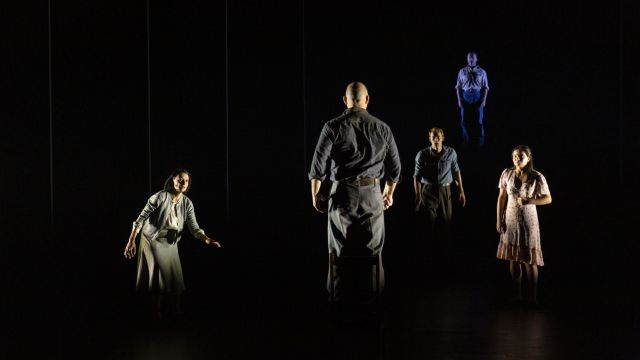A View from the Bridge
The incisive social realism of Arthur Miller’s writing is well fired up in this text. Here Miller focuses his attention on the inner workings of Italian-American post-war immigration. Eddie (Steve Bastoni), Beatrice (Daniela Farinacci) and Catherine (Zoe Terakes) appear as a typical successful immigrant family. Despite their struggles, they create a humble but loving home and are able to offer Catherine opportunities for a better life. However, as the story unfolds, we discover that their family dynamics harbour some dark secrets. These lurking and unspoken issues are exposed with the arrival of Beatrice’s two cousins from poverty stricken southern Italy. The two men enter the country illegally to seek their fortune in America and take refuge with the family. Marco (Damian Walsh-Howling) and Rodolph (Andrew Coshan) are presented as jovial and innocuous characters but they soon enter the fabric of the family’s life in ways that are intrusive and disturbing. The events are narrated by the cool and even tempered family lawyer, Alfieri (Marco Chiappi).
The ensemble cast showcases great examples of Australian talent. The evenness of the quality of their performances allows a deep level of intensity to characterise the mood of the play. The accuracy of the gestures and the accents and the way this elicits the historical moment is impressive. This draws attention directly to the characters and carefully avoids resorting to clichés or stereotypes. The tone is undoubtedly set by Bastoni who plays Eddie with a combination of affability and aggression. This makes him an alluring but unpredictable presence in the narrative. Zoe Terakes is outstanding in the way she captures a teenager on the brink of voluptuous womanhood. Her naivety in relation to the power this has over the men who dote on her is conveyed with a disarming naturalness and charm.
 The play is quite daring in its use of space. The sparse stage makes ingenious use of a combination of lighting, costuming and different stage areas. There is almost no set to speak of, but the effect is extremely striking. This effect foregrounds the characters in a way that echoes the intensity of the performances. However, this production is less daring in its development of the darker themes of the play. Eddie’s motives remain somewhat ambiguous despite clear references in the text to the issues which underpin the violence that erupts in the latter part of the play.
The play is quite daring in its use of space. The sparse stage makes ingenious use of a combination of lighting, costuming and different stage areas. There is almost no set to speak of, but the effect is extremely striking. This effect foregrounds the characters in a way that echoes the intensity of the performances. However, this production is less daring in its development of the darker themes of the play. Eddie’s motives remain somewhat ambiguous despite clear references in the text to the issues which underpin the violence that erupts in the latter part of the play.
The direction of this production is also quite visible; a great deal of the tension is produced in the quasi-stylised nature of the positioning of the characters combined with a deliberate heaviness in the delivery of some of the lines. This proves to be one of the strengths of the performance and exhibits a self-consciousness that makes interesting demands on the audience both visually and aurally. There are moments in which the characters emerge from or disappear into darkness which gives them a haunting and spectral quality. This serves to emphasise the artistry of the stage design and the innovative thought that has driven an intriguing approach to this masterpiece.
Patricia Di Risio
Photographer: Pia Johnson.
Subscribe to our E-Newsletter, buy our latest print edition or find a Performing Arts book at Book Nook.

